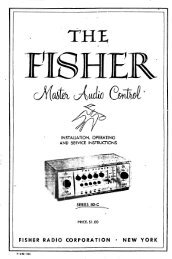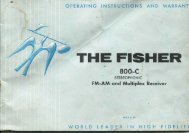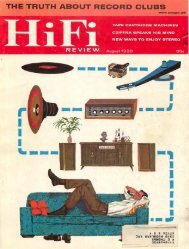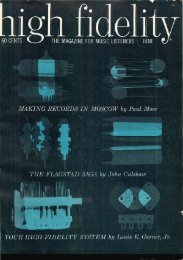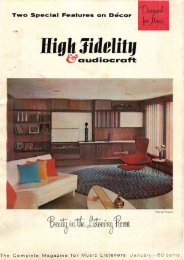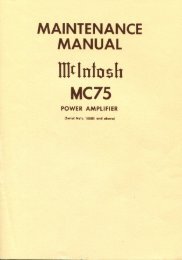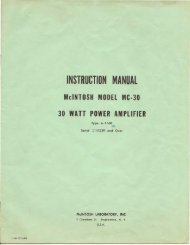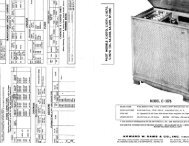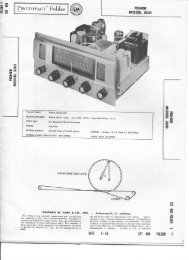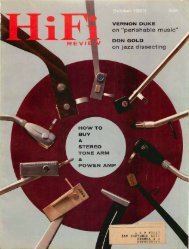~flr'6,r"®
Hifi Stereo Review â July 1958 - Vintage Vacuum Audio
Hifi Stereo Review â July 1958 - Vintage Vacuum Audio
- No tags were found...
You also want an ePaper? Increase the reach of your titles
YUMPU automatically turns print PDFs into web optimized ePapers that Google loves.
LOST ART OF COVERS<br />
(Continued from page 20)<br />
cover treatment. Most often this is done after the recording<br />
has been taped; but if it is a special release or<br />
an original cast show album, the cover may even be<br />
finished before the tape from the recording session has<br />
been edited; for it usually takes a good 90 days to produce<br />
from scratch a finished cover with program notes<br />
ready for the store. Once title and basic b·eatment<br />
have been agreed upon, it is up to the Design Director<br />
to carry out the idea as effective art which will both<br />
provoke the record dealer to give the disc prominent exposure<br />
on his shop's display shelves and entice the customer<br />
to buy the recording sight unheard, if need be.<br />
It's interesting at this point to sample<br />
the opinions of some of the record<br />
company art designers in terms of<br />
what they feel to be effective cover<br />
art saleswise. Very often these opinions<br />
will reflect the merchandising<br />
techniques and channeling adopted<br />
by the company in question. A mass<br />
merchandising outfit will take a quite<br />
different point of view from a specialty<br />
fum catering to a selected clientele.<br />
Art Director Bob Jones of RCA<br />
Victor sees no necessarily reliable<br />
relationship between so-called "good art" and "successful<br />
merchandisers." He makes particular note that<br />
many "fine examples of award-winning graphic art<br />
have not been successful merchandisers." A comparison<br />
of the best sellers as against cover art award<br />
winners from twelve leading record labels would seem<br />
to support this point of view.<br />
Caedmon's Belief<br />
On the other hand, Marianna Mantell and Barbara<br />
Cohen of Caedmon Records-primarily exponents of<br />
the spoken literary word on disc-believe that "an intrinsically<br />
good design definitely influences sales" -at<br />
which point they cite their Walter De la Mare disc<br />
with the cover designed by Matthew Liebowitz<br />
around a painting b y one of the most widely discussed<br />
West Coast modem painters, Morris Graves.<br />
Columbia, who pioneered the LP,<br />
also claims credit for sparking the<br />
trend which has led to that most<br />
ubiquitous of all record cover typesthe<br />
four-color photograph. This medium<br />
had now become almost as monotonous<br />
as the jungle of finned cars<br />
on the superhighways. When the fourcolor<br />
photo job is well done, it is not<br />
only a work of art which can sell records<br />
but can also cost a great deal of<br />
money. Columbia's cover for Reflections of an Indian<br />
Boy called for photographer Alan Reed to journey to<br />
the top of a mountain in Navajo territory to get just<br />
the right kind of shot with the right kind of mood. In<br />
the "no-title-no-text" category was Columbia's Songs<br />
of the West featuring the Norman Luboff Choir. Columbia,<br />
in company with Mercury and most recently<br />
26<br />
RCA Victor, has done large-scale repackaging of its<br />
earlier releases, dressing them up with brilliant fourcolor<br />
photos. Columbia, for one, cites an increase of<br />
200-percent in sales on some items as a result-which<br />
is to say that nothing can improve the appeal of an<br />
old house inside and out like a fresh coat of paint!<br />
Westminster's Point<br />
Wesbninster's Art Director, Igor Kipnis, concurs<br />
with Ernst Werner of Vox in a point worth making<br />
here-that the selling effectiveness of a record cover is<br />
closely tied up with the kind of music to be promoted.<br />
Names-personalities-are the important thing in jazz;<br />
but it is the so-called "MoodMusic" which is the most<br />
dependent on the right kind of cover for selling impact;<br />
for more often than not it is the<br />
"mood" that is being sold rather than<br />
Ansermet, Horowitz, Johnny Mathis,<br />
Louis Armstrong, or even the Tchaikovsky<br />
Piano Concerto. Therefore the<br />
cover art has to "pull" that much<br />
harder, or else.<br />
The endless variety of record covers<br />
extant these days speaks well indeed<br />
for the resourcefulness and taste<br />
of those responsible for them. When<br />
they miscalculate in one way or another,<br />
an aroused sales department, a<br />
miffed virhlOso, and a deluge of consumer complaints<br />
can be the result; but more often than not, barring a<br />
major "goof," the customer decries the tendency to<br />
sacrifice the essential spirit of the musical contents in<br />
the interest of "some infernal effort to be beautiful."<br />
Which brings us back to the matter of our opening<br />
paragraph-what you and I do about the really fine<br />
art which does turn up in record cover form occasionally<br />
and which we would even like to have on the<br />
wall rather than lost in our collections. RCA Victor<br />
did make a desultory attempt to solve this problem a<br />
few years ago when they sold their HMV series with<br />
removable art, sans title material, which could be<br />
framed. With or without typographical content, record<br />
companies do get requests from all over the counh·y<br />
for samples of their most effective covers for use in<br />
decorating rumpus rooms, lampshades, waste baskets,<br />
screens, and the like. Some firms and/or dealers are<br />
obliging with respect to such requests<br />
with or without a nominal charge; but<br />
the fact remains that once an LP goes<br />
into your collection its art, save for<br />
that contained within the grooves of<br />
the disc, is "lost art" indeed. Take a<br />
browse through your library for the<br />
best covers one day. You may find<br />
some pleasant and occasionally astonishing<br />
surprises.<br />
-END<br />
Don't forget the Rek-O-Kut Contest with first prize of<br />
a Sabena trip to Brussels. To enter, run down to your<br />
dealer's hi-fi salon and listen to a demonstration of his<br />
wares. Fill out a Rek-O-Kut entry blank (no 25 words<br />
gimmick), sit back and cross your fingers. By the way,<br />
prizes to the store owners (for best window displays)<br />
and 100 consolation prizes if you miss the one on top.<br />
HIFI & MUSIC REVIEW




